It’s intriguing how human perception works. We tend to believe we understand the nature or appearance of something merely because that’s the information our eyes relay to us, but our vision isn’t foolproof. Individuals can experience colorblindness, blindness altogether, or even be deceived. Often, we observe an image, and though our eyes interpret it one way, our minds perceive it differently. These physical realities, termed Optical Illusions, hold an immense allure for us as a species.
Here are 25 Mind-Blowing Optical Illusions That Play Tricks on Your Brain. Let the fascination continue.
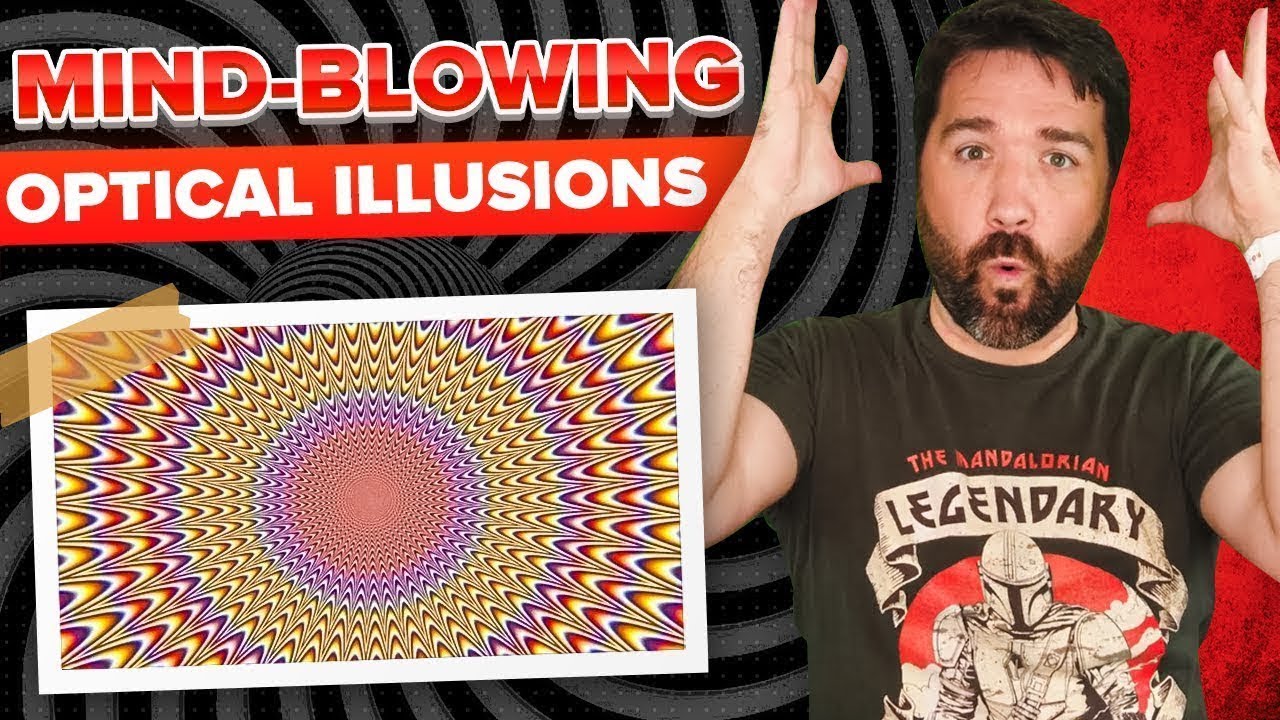
Motion Illusion
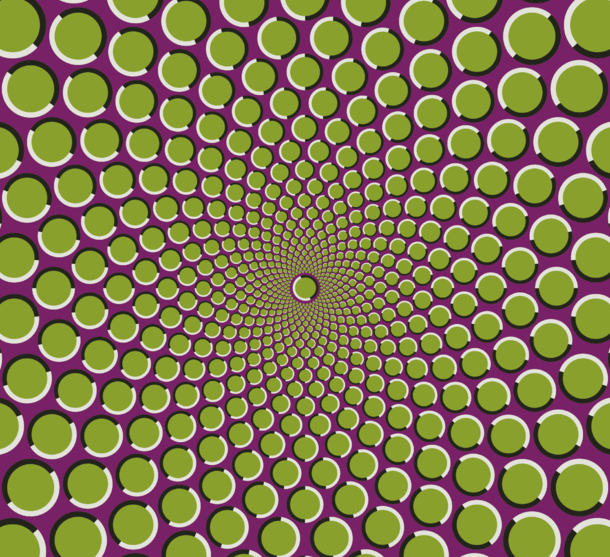 https://nypost.com/2022/06/24/eerie-optical-illusion-looks-like-its-moving-but-theres-a-trick-to-make-it-stop-can-you-do-it/
https://nypost.com/2022/06/24/eerie-optical-illusion-looks-like-its-moving-but-theres-a-trick-to-make-it-stop-can-you-do-it/ A very common type of optical illusions that often appears in media is called a motion illusion, in which an static, flat image appears to be moving. The contrasting elements of the image, like the colors, shapes, and positions, trick the brain into believing it is moving because the brain reads a change in light as movement. When one scans the image as a whole with a sweeping eye movement, they get the whole effect, but by focusing on the center, the illusion breaks and the image appears static again.
Figure-Ground (Perception)
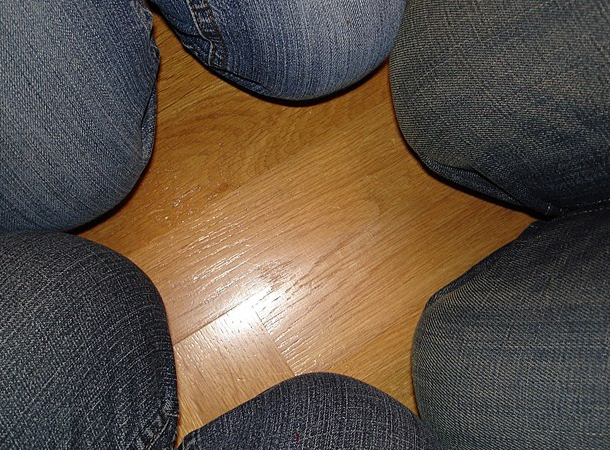 https://en.wikipedia.org/wiki/Figure%E2%80%93ground_(perception)
https://en.wikipedia.org/wiki/Figure%E2%80%93ground_(perception) When different images are placed strategically to form a completely separate image, it is referred to as a figure-ground. This illusion relies on perception by placing one or multiple objects in the foreground and others in the background to contrast images. In psychology, it helps determine how a specific person looks at an image by using the foreground and background, often whichever someone can identify first. For example, by adding the knees of jeans over a floor image, it makes the floor into the shape of a star, changing the background figure (as indicated in the name of the illusion).
Ambiguous Images
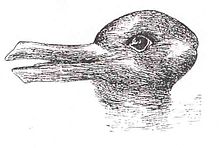 https://en.wikipedia.org/wiki/Ambiguous_image
https://en.wikipedia.org/wiki/Ambiguous_image Also called reversible images, reversible images use multiple figures seamlessly blended together to create one complete image. But because these contain multiple images, a phenomenon called multistable perception happens in which multiple images can be made out of one stable image. A famous example is the rabbit-duck illusion, in which the combining of images and use of negative space allows one to see both a rabbit and a duck in the same fluid image.
“Rubin Vase” Illusion
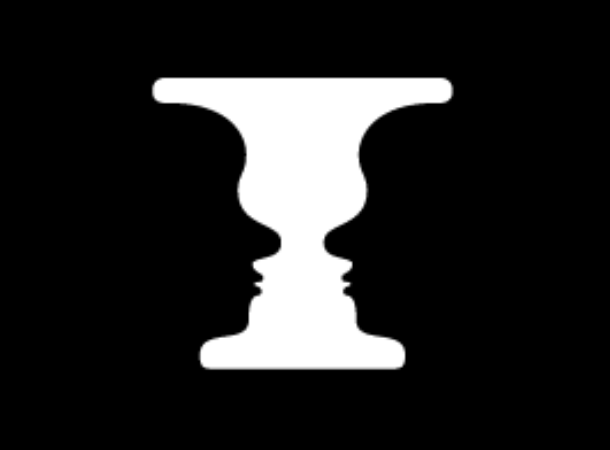 https://en.wikipedia.org/wiki/Figure%E2%80%93ground_(perception)
https://en.wikipedia.org/wiki/Figure%E2%80%93ground_(perception) The “Rubin vase” optical illusion uses two face images that are mirrored and form a vase in the middle. It is classified as a type of figure-ground illusion since it uses foreground and background to change the brain’s perspective. Like the figure-ground illusion, it allows psychologists to see how an individual views things based on whether they can identify the foreground or background image first. It is also classified as a famous example of an ambiguous image, since both figures can be perfectly seen.
“My Wife and Mother-In-Law”
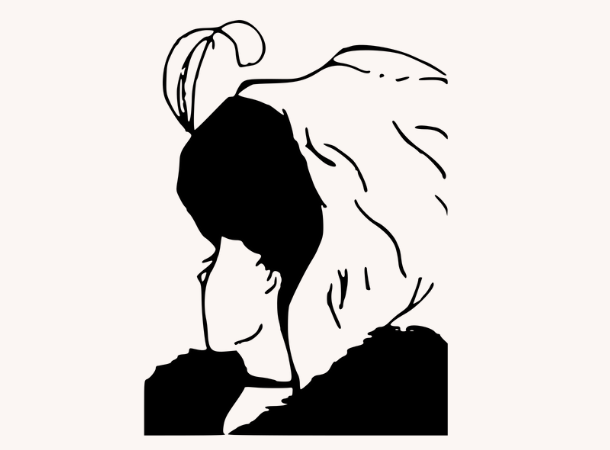 https://en.wikipedia.org/wiki/My_Wife_and_My_Mother-in-Law
https://en.wikipedia.org/wiki/My_Wife_and_My_Mother-in-Law Another prime example of the ambiguous image is the famous reversible image called “My Wife and Mother-In-Law,” in which in the same static image one can make out the figure of both a young woman and an older woman. While the oldest known version of this image first appeared on a German postcard in 1888, it was famously published in the American magazine Puck in 1915. It went on to be used in the psychology community as an ambiguous figure, as proposed by Edwin Boring in 1930.
The Barberpole Illusion
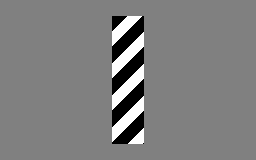 https://en.wikipedia.org/wiki/Barberpole_illusion
https://en.wikipedia.org/wiki/Barberpole_illusion First introduced in 1929 by psychologist J.P. Guilford and furthered in 1935 by Hans Wallach, the barberpole illusion refers to a paradox in which barber poles turn on their vertical axis, but the stripes appear to move upward rather than moving with the turn of the pole. This happens because the bar of contour allows for the actual motion of the lines (in this case, the blue and red stripes of the barberpole) to go many different possible directions. It creates the famed visual illusion we see today.
Beta Movement
 https://en.wikipedia.org/wiki/Beta_movement
https://en.wikipedia.org/wiki/Beta_movement For optical illusions regarding apparent motion, the term “beta movement” refers to when short projections of different figures create the appearance of movement. For example, the lighting of same-sized circles in short bursts creates the visual of the circles moving. It is used commonly in animation, but also played a part in the founding of Gestalt psychology. Sometimes it is also confused with “pure phi phenomenon,” which describes apparent motion when two nearby stimuli are used in congruence with each other – although beta movement covers a broader range of these apparent motion illusions compared to the narrower view of the phi phenomenon.
The Bezold Effect
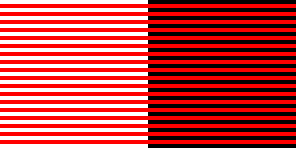 https://en.wikipedia.org/wiki/Bezold_effect
https://en.wikipedia.org/wiki/Bezold_effect Named after the meteorology professor who discovered it, a German man named Wilhelm von Bezold, the Bezold effect is an optical illusion that causes a change in color when another color is applied adjacent to it in an image. In a prime example where a series of red lines are placed over both a white background and a black background, the red color of the lines with the black background appears darker and bolder compared to its white-background equivalent, even though the red is the same shade throughout the entire line, no matter the background color.
The Checker Shadow Illusion
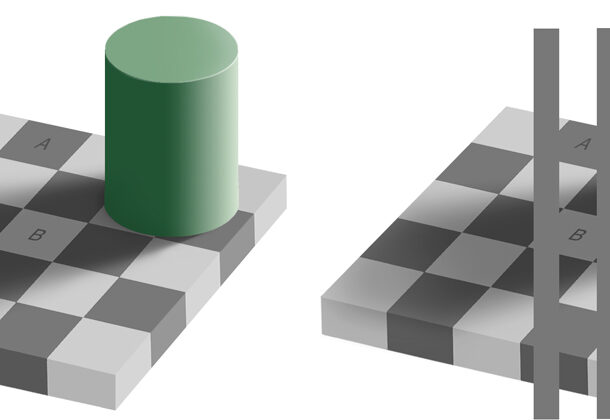 https://en.wikipedia.org/wiki/Checker_shadow_illusion
https://en.wikipedia.org/wiki/Checker_shadow_illusion Originally published in 1995 by MIT professor of vision science Edward H. Adelson, the checker shadow illusion depicts an image with darker and lighter gray checkered squares being partially obscured by another object. The optical illusion comes into effect because to the human brain, the coloring of a darker square not affected by the shadow (labeled “A” in the image) is darker than a lighter square affected by the shadow (labeled “B”), when in actuality, they are of equal brightness.
Cornsweet Illusion
 https://en.wikipedia.org/wiki/Cornsweet_illusion
https://en.wikipedia.org/wiki/Cornsweet_illusion Similar to the checker shadow illusion, the cornsweet illusion deals with shades of gray as they fade to make images appear different, therefore being classified as an illusion. In a good example of the cornsweet illusion, it shows one half of an image (in this case, the left) appearing lighter than its (right) half when they are actually of the same brightness due to the gradient fading of dark to light gray on both sides. Because of the gradients, it appears as though the entirety of one side is lighter than the other.
Ebbinghaus Illusion
 https://en.wikipedia.org/wiki/Ebbinghaus_illusion
https://en.wikipedia.org/wiki/Ebbinghaus_illusion Also called Titchener Circles, the Ebbinghaus illusion uses relative size to change perception, making figures of the same size and shape appear different based on their surrounding images. Based on the relative size and distance of the figures in which the central, same-sized circles are surrounded by, the brain is tricked into believing the central circle surrounded by smaller, closer circles (the right image) is actually larger than the left central circle surrounded by larger, further circles. The alternative names come from who originally discovered it – German psychologist Hermann Ebbinghaus – and who presented it to English speakers for the first time – Edward D. Titchener.
Delboeuf Illusion
 https://en.wikipedia.org/wiki/Delboeuf_illusion
https://en.wikipedia.org/wiki/Delboeuf_illusion This optical illusion, created initially by Joseph Remi Leopold Delboeuf in 1865, distorts perspective by surrounding dark discs of the same size and shape with different sized rings in order to make one of the discs (the left, in this example) seem smaller than the other. The further the surrounding ring is to the disc, the smaller it seems compared to one of closer proximity. In 2005, it was suggested this effect falls in line with the Ebbinghaus illusion, as they share a similar idea.
Forced Perspective
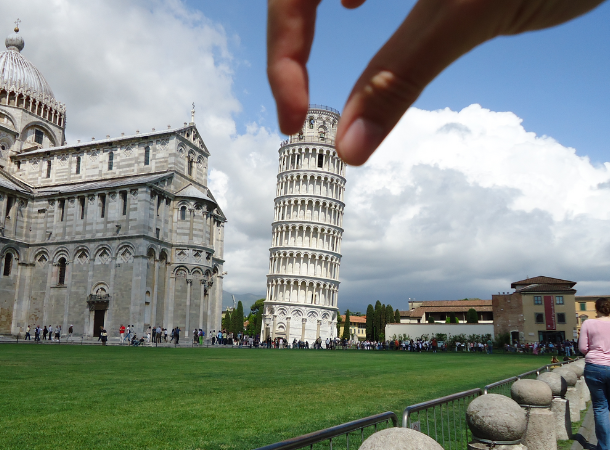 https://en.wikipedia.org/wiki/Forced_perspective
https://en.wikipedia.org/wiki/Forced_perspective To garner forced perspective, one must use a technique in order to create the optical illusion itself. With forced perspective, one can manipulate visual perspective in order to make an object look further away, closer, or a different size than it actually is. Perhaps the most famous example is in photography, when the photographer uses vantage point and depth perception to trick the brain with this illusion. It is also commonly deployed in film, art, and theme parks to achieve the same effect.
Gravity Hill
 https://en.wikipedia.org/wiki/Gravity_hill
https://en.wikipedia.org/wiki/Gravity_hill Not always intentional, the gravity hill illusion is where a specific land layout causes an optical illusion that makes a slight downward slope appear to instead be upward. It can go by many different names, such as a mystery spot or mystery hill, and can be a local attraction of sorts, like the Magnetic Hill in Moncton, Canada. Wherever one can see it, it is a fun illusion that always makes us look twice.
Impossible Cube
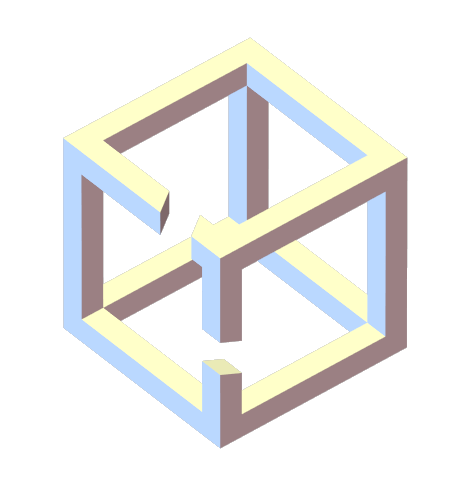 https://en.wikipedia.org/wiki/Impossible_cube
https://en.wikipedia.org/wiki/Impossible_cube An impossible object is a two-dimensional (2D) image that is made to represent a three-dimensional (3D) figure without being able to exist as a solid 3D object. Impossible objects appear as images attempting to defy the laws of geometry without actually doing so. The most common example is that of the impossible cube, which was actually invented by Dutch artist M.C. Escher for his lithograph print Belvedere. One has also been notably featured on an Austrian postage stamp.
Mach Bands
 https://en.wikipedia.org/wiki/Mach_bands
https://en.wikipedia.org/wiki/Mach_bands Physicist Ernst Mach reported this optical illusion that took his name in 1865; Mach bands are classified by bands that showcase different shades of gray in order to highlight the contrast between the edges of each band. When the bands touch, it exaggerates the edges of each band more than when they are separate, creating an optical illusion.
Müller-Lyer Illusion
 https://en.wikipedia.org/wiki/M%C3%BCller-Lyer_illusion
https://en.wikipedia.org/wiki/M%C3%BCller-Lyer_illusion This common illusion, dubbed the Müller-Lyer illusion and named after its original designer German sociologist Franz Carl Müller-Lyer in 1889, consists of line segments flanked by arrow “tails” facing in different directions. Although both line segments are of the same length, the segment with tails that face toward the line make it appear longer than the segment with tails that face away from the line. Although the physical length of the lines are the same, this illusion alters perception to make them seem different.
The Penrose Triangle
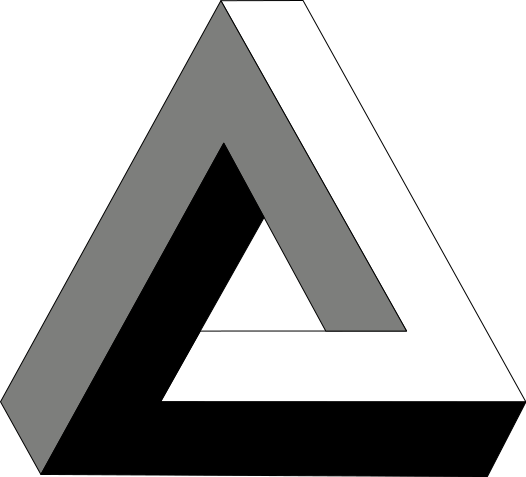 https://en.wikipedia.org/wiki/Penrose_triangle
https://en.wikipedia.org/wiki/Penrose_triangle Another example of an impossible object, the Penrose triangle is the triangular equivalent to the impossible cube, manipulating a two-dimensional image of a triangle to appear as if it is three-dimensional. The Penrose triangle was created first in 1934 by Oscar Reutersvärd, a Swedish artist, and then in the 1950s independently crafted and made popular by psychiatrist Lionel Penrose and his Nobel-prize winning mathematician of a son, Sir Roger Penrose.
Sander Illusion
 https://en.wikipedia.org/wiki/Sander_illusion
https://en.wikipedia.org/wiki/Sander_illusion Also known as Sander’s parallelogram, the Sander illusion was coined by the German psychologist of the same name in 1926, even though it had been published earlier in 1922 by Matthew Luckiesh. This optical illusion uses a bisected parallelogram to illustrate depth perception, as the blue lines bisecting each side of the parallelogram appear to be different lengths (the left-side being considerably longer) when they are, in fact, the same.
Lilac Chaser
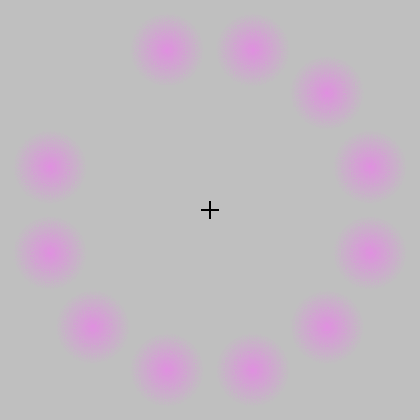 https://en.wikipedia.org/wiki/Lilac_chaser
https://en.wikipedia.org/wiki/Lilac_chaser Possibly the best-known example of the Troxler’s fading optical illusion and the phi phenomenon, the lilac chaser consists of 12 lilac discs, blurred and arranged in a larger circle, around a small central point – usually represented by a cross – on a grayscale background. One disc will disappear for a brief moment only for the next to disappear immediately after, continuing clockwise around and around again. Upon staring at the cross in the center for around 30 seconds, three illusions emerge: a gap in the circle of discs, then a green disc in place of the aforementioned gap, followed by the green disc alone on the gray background, the lilac discs having disappeared.
Zöllner Illusion
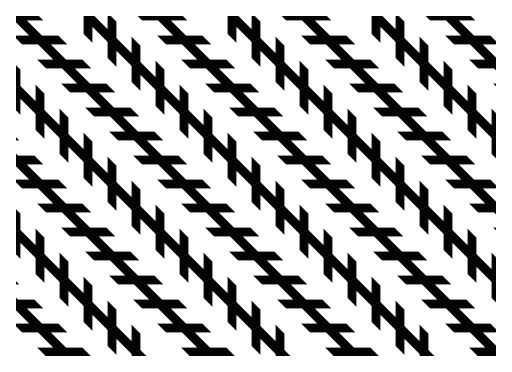 https://en.wikipedia.org/wiki/Z%C3%B6llner_illusion
https://en.wikipedia.org/wiki/Z%C3%B6llner_illusion This optical illusion named after its founder – German astrophysicist Johann Karl Friedrich Zöllner – usually consists of multiple parallel black lines in a diagonal fashion. These lines are then crossed by repeating short black lines, alternating horizontal and vertical on the parallel lines. Because the repeating lines strike the parallel lines at an angle, it creates the illusion that one end of the parallel lines is nearer to that of the viewer than the other side. It is heavily influenced by depth perception and background effects, which contribute to the illusion.
Poggendorff Illusion
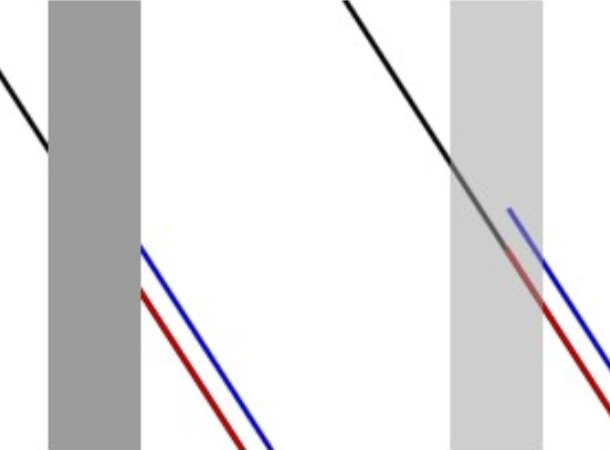 https://en.wikipedia.org/wiki/Poggendorff_illusion
https://en.wikipedia.org/wiki/Poggendorff_illusion Closely associated with the Zöllner and Müller-Lyer illusions, the Poggendorff illusion creates the illusion that a continuous line segment has been interrupted by an obscuring object, when in actuality, the line is not continuous. Because of the contour of the shape doing the obscuring, however, it can make it look continuous. This tricks the brain with misperception, much like the Zöllner and Müller-Lyer illusions do. They are all considered geometrical-optical illusions.
Wundt Illusion
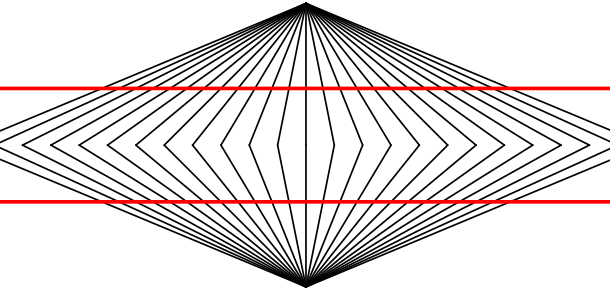 https://en.wikipedia.org/wiki/Wundt_illusion
https://en.wikipedia.org/wiki/Wundt_illusion First explained in the 19th-century by German psychologist William Wundt, the Wundt illusion describes two straight red lines over a background of crooked lines in a diamond-like shape. The background distorts the shape of the straight red lines to make them seem curved in toward each other.
Hering Illusion
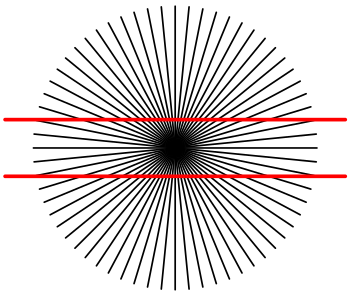 https://en.wikipedia.org/wiki/Hering_illusion
https://en.wikipedia.org/wiki/Hering_illusion While the Wundt illusion makes lines appear to be bowed inward, the Hering illusion takes the same basic principle and inverts it. With this optical illusion, it takes the base ideas of the Wundt illusion – two straight red lines sitting parallel to each other over a distorted background – while having the opposite effect: the lines begin to appear as if they are curving away from each other due to the shape of the background, often a radial background. So where the Wundt illusion bends inward due to the density of the background lines being higher outside the red lines, the Hering illusions bends outward because the density of the background lines are inside, or between, the red lines.
Orbison Illusion
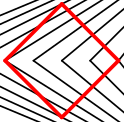 https://en.wikipedia.org/wiki/Orbison_illusion
https://en.wikipedia.org/wiki/Orbison_illusion A popular optical illusion and famed variant of both the Wundt and Hering illusions, the Orbison illusion is credited to American psychologist William Orbison in 1939. It uses a two-dimensional figure such as a square or circle and puts it over a background of lines or circles. The illusion affects not only the central shape but the shape of the image (usually a rectangle) which contains the whole illusion – both become distorted, the central figure of a square seeming bulged, and the whole rectangular image appearing tilted.
If you enjoyed this article, check out 25 Optical Illusions And Phenomena Only Seen In Nature.
Lists Going Viral Right Now
"Motion illusion in star arrangement" by Fiestoforo is licensed under CC BY 3.0 .



























